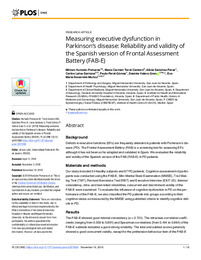Por favor, use este identificador para citar o enlazar este ítem:
https://hdl.handle.net/11000/35845
Measuring executive dysfunction in Parkinson’s disease: Reliability and validity of the Spanish version of Frontal Assessment Battery (FAB-E)
Título :
Measuring executive dysfunction in Parkinson’s disease: Reliability and validity of the Spanish version of Frontal Assessment Battery (FAB-E) |
Autor :
HURTADO-POMARES, MIRIAM 
Terol Cantero, M Carmen 
Sanchez-Perez, Alicia 
Leiva-Santana, Carlos 
Peral-Gómez, Paula 
Valera-Gran, Desirée 
Navarrete-Muñoz, Eva María  |
Editor :
Public Library of Science |
Departamento:
Departamentos de la UMH::Patología y Cirugía
Departamentos de la UMH::Ciencias del Comportamiento y salud |
Fecha de publicación:
2018-11-19 |
URI :
https://hdl.handle.net/11000/35845 |
Resumen :
Abstract
Background
Deficits in executive functions (EFs) are frequently detected in patients with Parkinson’s disease
(PD). The Frontal Assessment Battery (FAB) is a screening test for assessing EFs although it has not been so far adapted and validated in Spain. We evaluated the reliability
and validity of the Spanish version of the FAB (FAB-E) in PD patients.
Materials and methods
Our study included 54 healthy subjects and 67 PD patients. Cognitive assessment of participants
was conducted using the FAB-E, Mini-Mental State Examination (MMSE), Trail Making Test (TMT), Revised-Barcelona Test (RBT) and Executive Interview (EXIT-25). Internal consistency, intra- and test-retest reliabilities, concurrent and discriminant validity of the FAB-E were examined. To evaluate the influence of cognitive dysfunction in PD on the performance of the FAB-E, we also classified the PD patients into groups according to their cognitive status as measured by the MMSE using published criteria to identify cognitive déficits in PD.
Results
The FAB-E showed good internal consistency (α = 0.751). The intraclass correlation coefficients
(ranging from 0.559 to 0.891) and Spearman correlations (from 0.494 to 0.864) of the
FAB-E subtests indicated a good-strong reliability. The total and subtest scores generally
showed a good concurrent validity, except for the prehension behaviour item of the FAB-E and the Interference and Go/no-go tasks of the EXIT-25 that presented low estimates.
Excluding the prehension behaviour subtest, the performance of the FAB-E was higher in the control group than in PD patients. Cognitive dysfunction in PD patients also indicated significant poorer FAB-E scores excepting the motor and prehension behaviour subtests. Discriminant analysis determined a cut-off of 14.5 was optimal to differentiate healthy subjects from PD patients. Moreover, a cut-off <12.5 allocated satisfactorily those PD patients with cognitive impairment (MMSE<26) and scores <11.5 classified suitably those PD patients with dementia (MMSE<24).
Conclusion
The FAB-E is an accurate tool for evaluating EFs in patients with PD and can provide useful
information for distinguishing PD patients with and without cognitive dysfunction at a bedside
assessment.
|
Tipo de documento :
info:eu-repo/semantics/article |
Derechos de acceso:
info:eu-repo/semantics/openAccess
Attribution-NonCommercial-NoDerivatives 4.0 Internacional |
DOI :
https://doi.org/10.1371/journal.pone.0207698 |
Publicado en:
PLoS One. 2018 Nov 19;13(11):e0207698 |
Aparece en las colecciones:
Artículos Patología y Cirugía
|
 La licencia se describe como: Atribución-NonComercial-NoDerivada 4.0 Internacional.
La licencia se describe como: Atribución-NonComercial-NoDerivada 4.0 Internacional.

 La licencia se describe como: Atribución-NonComercial-NoDerivada 4.0 Internacional.
La licencia se describe como: Atribución-NonComercial-NoDerivada 4.0 Internacional.
.png)